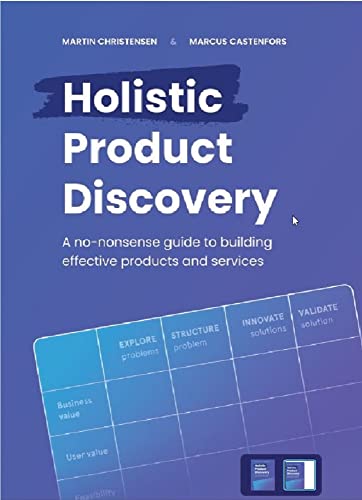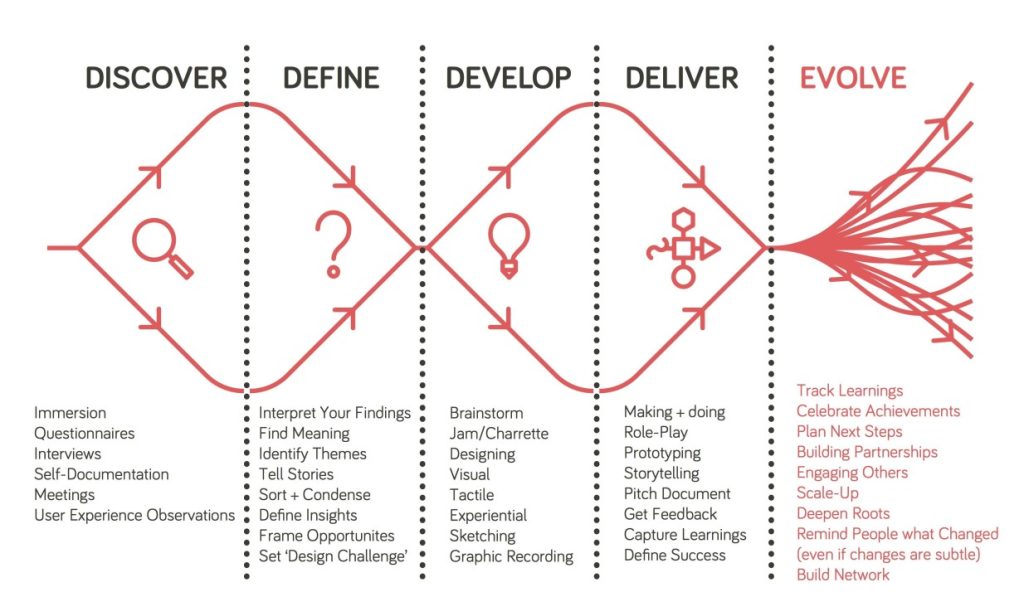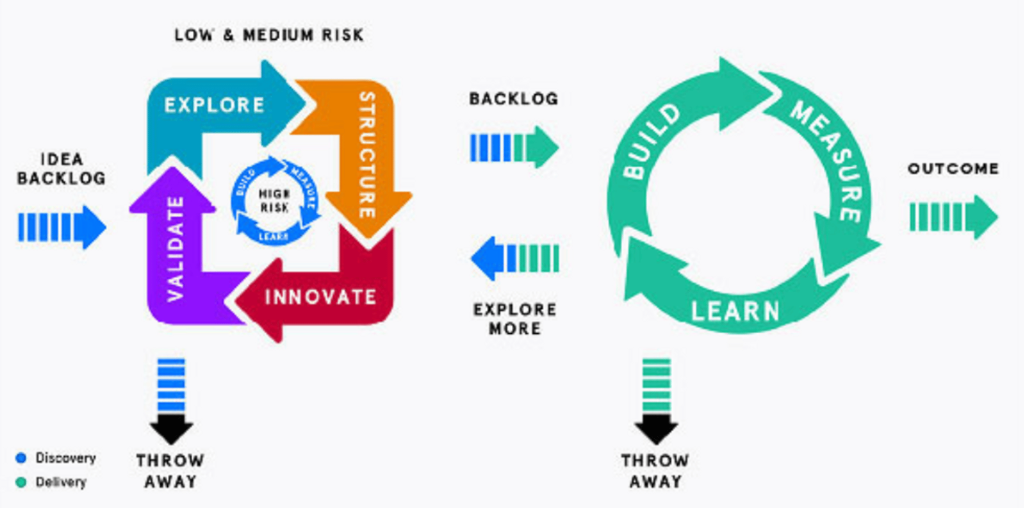
Review
This is a great product discovery reference book. It brings together product discovery and delivery, and provides a great overview of the theory to date. It’s a book without ego, introducing just a couple of frameworks whilst signposting other important work. It doesn’t quite achieve a single theory that ties everything together, which is a shame. I do love though that it assumes a little product knowledge, which is refreshing as it allows for brevity. Well worthy of a read.
Key Takeaways
The 20% that gave me 80% of the value.
- Why it’s so hard to build technology that achieves outcomes:
- Confirmation Bias: Undervaluing facts that don’t confirm what you believe, and favoring information that does
- Optimism Bias: We are less likely of experiencing a negative event compared to others
- Valuing outputs over outcomes: ideas are useless unless they solve a problem
- IKEA effect: If we ourselves are the creators, we perceive our creations as more valuable that what they really are
- Unchallenged assumptions: assumptions often remain unchallenged due to confirmation bias. It’s really easy to underestimate what happens if an assumption is false
- Sunk cost fallacy: when people involved feel like they’ve invested too much time and effort. They don’t want that to be a waste
- Siloed work: everyone just focuses on execution, rather than challenging existing assumptions
- More output fallacy: the belief that the more work we do the better it will be.
| Stage | What it’s for | Currency |
|---|---|---|
| Discovery | Figuring out what to build. Ensuring what you’re creating is valuable. | Knowledge |
| Delivery | Building it. Realizing your creations. | Value |
- Rule of thumb: Discovery should take about 10% of build time
Product Discovery Principles
- Problem-first approach over solution-first
- Fall in love with the problem not the solution
- Drill down to the core of the problem.
- Keep the problem top-of-mind, never forget the problem you’re solving.
- Outcomes over outputs
- it’s the outcome and impact that counts
- Team diversity, trust & openness over individual effort
- Diversity, inclusion, psychological safety, collaboration
- Diverse teams are 20% better at innovation and reduce risk by 30% (Source: Deloitte diversity and inclusion revolution)
- Holistic view over local optimization
- Get the valuable perspectives of different disciplines
- Look beyond your silo, beyond your job, focus on what the company needs to achieve
- Continuous discovery over unplanned exploration
- The future is unknowable if you work in a complex domain. The only way to operate is to sense and respond
Discovery Frameworks
- Being iterative and incremental allows good feedback loops
- Three Qualities of Successful Products:
| Qualities | Questions |
|---|---|
| Viability Business value. A product that will generate profit (in the short-run and long-run) | Should we build the product? Help meet business goals? Help meet business needs? Part of business strategy? |
| Desirability User value. A product that will solve a problem for the user. | Do they need the product? Help the customer produce the right result? Help them in an efficient way? Fulfill the needs of the customer? |
| Feasibility Practical feasibility. A product that can be reasonably made given current conditions. | Can we sustainably build the product? Fit within ecosystem of products and services? Fit in the current business? Have the competencies and resources? Reasonable to build in the long-run? How to build it? With what technology? |
- The three types of risk: user value, business value, feasibility
- What’s the least amount of discovery we need to do to address a particular risk?
- Four stages for clarity / The double diamond

| Diamond 1 Find the right problem | 1. Explore problems | Discover the problem Who are the stakeholders? Who are the users? What is the context? |
| 2. Structure problems | Making sense of insights and creating once concise explanation of it Clustering problem areas Drawing conclusions Validating problem definitions Decide on scope for solution discovery | |
| Diamond 2 Find the right solution | 3.Innovate solutions | Coming up with possible solutions Generating a broad set of ideas |
| 4. Validate solutions | Making certain the solution actually solves the problem Create something that can be tested quickly Ends in a decision of what to build |
The powerful holistic framework
| Diamond 1 | Diamond 2 | |||
| 1. Explore problems | 2. Structure problems | 3.Innovate solutions | 4. Validate solutions | |
| Business Value | Market Landscape? | Gap in the market? | How to exploit gap? | Does exploit give intended outcome? |
| User Value | User context? | Most important user needs? | What solutions could fulfill needs? | What solutions fulfill needs best? |
| Feasibility | What is our current capability? | What is our main practical opportunity? | What could we build? | What should we build, sustainably? |
- The framework can help you understand what you historically did, or are presently doing:
- It can help you identify how ‘holistic’ is the approach you’re taking to discovery
- Are we assessing the risks well?
- Do we understand the full scope of the problem?
- Are we choosing the smartest way to visualize the solution at this stage?
- Are we evaluating with the right kind of people in a way that fits them?
- Will this activity make us learn the most?
- It can help you identify how ‘holistic’ is the approach you’re taking to discovery
- It can help you evaluate your toolbox, do you have questions, workshops and artifacts you can use in each box?
| 1. Explore problems | 2. Structure problems | 3.Innovate solutions | 4. Validate solutions | |
| Business Value | · Stakeholder Interviews · Business analysis · Competitive analysis · Assumption Mapping · Requirements elicitation | · Business goals · Business model canvas · Lean canvas · Opportunity solution tree · Impact mapping · OKRs · Requirements analysis · Hypotheses · User stories · Job stories | · User story mapping · Value prop. design | · Lean startup validations · Requirements validation |
| User Value | · User interviews · Customer service interviews · Analytics review · Task analysis · Heuristic evaluation · Assumption mapping | · Persona · Hypotheses · User stories · Job Stories · Customer journeys · Opportunity solution tree · Impact mapping · Service Blueprint · Empathy mapping | · Design studio · Participatory design · Oblique strategies · Future user journey · Prototypes · Idea generation, development & selection | · User testing · Usability testing · Wizard of Oz · Role playing · Concierge · Landing page |
| Feasibility | · Gartner’s hype curve · Wardley mapping · Competitive analysis · Event storming | · Tech choice canvas · Service blueprint · Emergent architecture · Architectural model | · Thoughtworks tech radar · Spikes · Proof of concept | · Spikes · Proof of concept |
- Use the power of triangulation throughout discovery: Use several methods for each part of the matrix to make sure you cover as much ground as possible.
Known Playbook: Focused on User value:
- Hypothesis: We believe customers have [problem x]. If we provide [solution y], we will see [desired outcome z].
- Don’t be rigid about structure, but mention the problem you want to solve, a high-level solution statement and intended outcome.
- Design Studio: Illuminate the problem with a presentation. Sketch solutions with everyone. Present back. Critique to highlight key concerns, does it solve the problem?. Iterate and loop back multiple times until you have a shared understanding of the problem and some good ideas.
- Prototype: create something tangible that you can test on users
- User test: Test your prototype on real users.
- Book recommendation: Rocket Surgery Made Easy
- Team Pitch: playback to a larger group of stakeholders and colleagues. Get feedback from a business/ organizational perspective
UnKnown Playbook focused on User Value:
- Research questions: Host a workshop with the team to gather research questions they have about the subject. Create an affinity map of the stickies, cluster them in different categories. Dot-vote on the most important research questions.
- User research: Use 3 sources to gather research data (e.g. analytics, user interviews, customer support), Triangulate and validate the data from multiple perspectives
- Design Sprint: Synthesize insights and create tangible solutions.
- Benefits: focus, time-boxed, functional , invite people from diverse perspectives, you have all the tools at your disposal
- Team Pitch: Invite a wider group to review what you’ve accomplished and feedback
Bring your product and design functions together
- Avoid your design function continually working in a studio model without other functions. You risk their discoveries not being linked to the priorities of the business, getting stuck half finished with no clear learnings as a result
- Get to transparency, show where every initiative is:
- Doing so will:
- More discoveries will move into delivery
- Relationships will improve between product and design
- Product will get better at discovery
- Discovery items will be linked to business goals
- More transparency on what’s in flight
- Common vocabulary and toolkit
Strategic Product Discovery
- Set measurable goals early for business value and customer value early on.
- Follow up on them as often as possible
- Express goals as desirable outcomes (or impacts → what happens when you achieve a goal)
- Establish and keep a clear connection between the goals throughout the process
- Tool: Opportunity Trees (Teresa Torres)
- Tool: Impact mapping (InUse by Gojko Adzic)
- Structure problem space exploration → prioritize throughout development
- SMART goals are great. Specific, measurable, attainable, relevant, time based
- Goals should be outcome based → so they’re solution agnostic
- Impact mapping is good for when the emphasis is on different types of users
- Set and continuously measure the outcomes of business value and user value goals helps us to be strategic about product development from start to finish.
| Explore Problems | Structure Problem | Innovate Solutions | Validate Solution | Build Solution | Measure Outcomes |
| Find outcomes | Set Goal | Estimate goal reach | Measure outcomes | ||
| Find needs | Baseline Measuring | Measure needs | Measure needs |
- Feasibility Discovery in a nutshell:
- What skills do you have in the company?
- What technologies that you’re using might soon be obsolete
- What new technologies are there?
- How should we build things sustainably?
- What new competencies we need to develop?
- How we need to restructure organization to meet future?
- Use Wardley Mapping to map: user needs → capabilities
- Use Thoughtworks Tech Radar to find a new potential solution and then build a spike to check if works
Discovery and Delivery sitting in a tree
- Product Discovery: Figuring out what to build
- Product Execution: Building it
- Product Definition
- Product Delivery
- Don’t confuse product definition with discovery.
- Discovery → Learning → Knowledge
- Delivery → Creating outcomes → Value
- Discovery isn’t a phase → It’s a mindset. Ideally we’d do it continuously.
- Feel you’ve learnt enough? → Be confident and move to delivery
- Feedback shows you don’t understand enough? → Be confident you should discover more
- Empowered teams and the Trio:
- Designer → customer point of view, user value
- Product → business view, value of the product
- Engineer → technology view, responsible for feasibility
- All → bring in additional expertise as required
- Discovery Brief
- Data: What trends are we seeing? (customer, sales, technology)
- Insight: Based on data, what are some clear insights we can leverage?
- Assumption: What are we assuming based on insights?
- Value: What’s the initial idea of the value proposition?
- Success: What does success look like?
- Discovery Stories: You can mix discovery and delivery by having discovery stories.
- Discovery Kanban: Work on the highest priority thing, balance learning rate and development rate over time

- Not all problems are complex, and demand an iterative approach.
- Divide risk into 4 levels:
- No risk: Obvious problems → straight to delivery
- Low risk: Complicated problems → discovery process using playbook (mitigate risks)
- Medium risk: Complex problems → holistic discovery (iterate and increment through it)
- High risk: Complex problem, where if invalidated the product fails → quickly validate or invalidate our assumptions (e.g. Lean Startup)
- Ask the questions…
- How well do we understand the problem?
- How well do we understand the solution?
- Continuous Collaborative Discovery and Delivery:
- No risk? Go straight to delivery: Build, Measure, Learn
- Step A: No discovery Required
- Step B: Delivery (Build, Measure, Learn)
- Low/ Medium risk?
- Step A: Discovery Playbook (Triangulation Methods, double diamond)
- Step B: Delivery (Build, Measure, Learn)
- For high risk do Build, Measure, Learn loop before building
- Step A: Discovery assumption exploration (Build, Measure, Learn)
- Step B: Delivery (Build, Measure, Learn)
- No risk? Go straight to delivery: Build, Measure, Learn

- Barriers to good discovery:
- Lack of time and budget
- Lack of buy-in and hard to prove value
- Lack of involving the right people
- Lack of access to users
- Change Model (Kurt Lewin):
- Thawing:
- Getting ready to change
- Establish that change in necessary
- Getting ready to leave comfort zone
- Compelling message required to get people to let go
- Having insight into the disease when you’re ill
- Transitioning:
- Making the changes that are needed
- A process, a transition
- Involve people in the process changes
- Get people’s feedback?
- Is it working
- Get to a shared understanding
- Freezing
- Make the change permanent
- Develop ways to sustain the change
- Thawing:
- Peter Axbom’s Building Blocks for Change
- Lippitt-Knoster Model for Managing Complex Change, helps focus effort on a goal
| Goal | – Missing – | Goal | Goal | Goal | Goal |
| Competence | Competence | – Missing – | Competence | Competence | Competence |
| Motivation | Motivation | Motivation | – Missing – | Motivation | Motivation |
| Resources | Resources | Resources | Resources | – Missing – | Resources |
| Action Plan | Action Plan | Action Plan | Action Plan | Action Plan | – Missing – |
| = | = | = | = | = | = |
| Change | Confusion | Anxiety | Resistance | Frustration | Restarts |